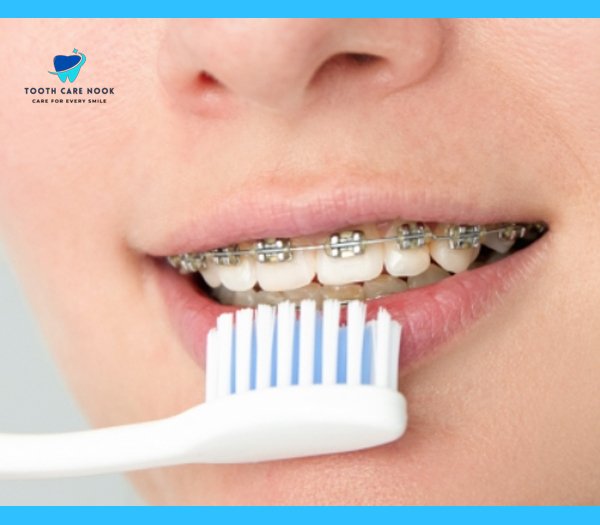Ceramic Braces vs Metal Braces
Orthodontic treatments have evolved significantly over the years, offering a range of options to help individuals achieve straighter teeth. Among the most common choices are ceramic braces and metal braces. Both offer effective solutions for aligning teeth, but they are different in aesthetics, cost, and comfort. This article explores the key differences between ceramic braces and metal braces, helping you make an informed decision based on your specific needs and preferences.
What Are Ceramic Braces?
Ceramic braces are a popular orthodontic option for those seeking a less noticeable treatment. Unlike traditional metal braces, they have clear or tooth-colored brackets, making them blend with the natural color of your teeth. This aesthetic advantage is one of the primary reasons why people opt for them, especially adults and teenagers who may be self-conscious about wearing braces.
What Are Metal Braces?

Metal braces, also known as traditional braces, are the most widely used orthodontic treatment. Made from stainless steel, metal braces are highly durable and effective at treating a wide range of dental misalignments. While they are more visible than ceramic braces, their strength and ability to treat complex cases make them a preferred choice for many individuals.
Pros and Cons of Ceramic Braces
Pros
- Clear braces blend naturally with teeth, making them less noticeable than metal braces.
- The smooth brackets minimize irritation to the gums and cheeks.
- A popular choice for adults who prioritize a discreet orthodontic solution.
Cons
- Ceramic braces are more expensive than metal braces but offer significant aesthetic advantages.
- Clear brackets can discolor without proper care and hygiene.
- Material is more delicate and requires careful handling to prevent chipping.
Pros and Cons of Metal Braces
Pros
- Metal braces are strong, long-lasting, and less likely to break.
- Ideal for correcting complex dental issues, often resulting in shorter treatment times.
- Metal braces are more budget-friendly compared to other alternatives.
Cons
- Their metallic look is more conspicuous, which some may find unappealing.
- The bulkier brackets can irritate until the mouth adjusts.
Understanding the Costs
Ceramic braces are typically more expensive than metal braces. On average, ceramic braces can cost anywhere from $4,000 to $8,000, depending on factors such as location, orthodontist fees, and the complexity of the case.
Comparing the Differences
Feature |
Ceramic Braces |
Metal Braces |
| Appearance | Tooth-colored bracket, discreet, ideal for adults and teens | More noticeable, customizable with colorful elastics |
| Durability | Strong but may chip or stain; requires careful handling | Highly durable, ideal for active individuals |
| Comfort | Smooth surface but may cause slight gum irritation | May feel bulkier initially but adjustable for comfort |
Do Ceramic Braces Stain?

When it comes to ceramic braces, one common concern is staining. The good news? The ceramic brackets themselves are resistant to discoloration and remain as clear and subtle as the day they were placed. However, the clear elastic bands that secure the archwire to your brackets are a different story.
While clear bracket braces are less noticeable, they may require extra care to avoid discoloration, especially the clear elastics that secure the archwires.
Common Causes of Staining:
- Pigmented Foods and Drinks: coffee, tea, curry, red wine, and even brightly colored sauces can stain elastics.
- Smoking: Tobacco can cause yellowing of the elastic bands.
- Inadequate Oral Hygiene: food particles left on braces can lead to staining and plaque buildup.
Essential Maintenance Tips
Proper care of your braces is essential to ensure effective treatment and maintain their appearance throughout the orthodontic process. Whether you choose ceramic or metal braces, these maintenance tips will help you keep your braces and teeth in excellent condition:

Use a Soft-Bristled Toothbrush
A soft-bristled toothbrush is gentle on both your brackets and gums, reducing the risk of damage or irritation. Regular brushing with a soft brush prevents plaque buildup and promotes excellent oral hygiene during your treatment. This is particularly important for white braces, as proper brushing helps prevent discoloration of the clear elastics.
- Avoid Hard or Sticky Foods
Certain foods can damage your braces or get stuck in the wires, causing discomfort or delays in treatment. Steer clear of hard foods like popcorn, ice, and nuts, as well as sticky options like caramel or chewing gum. These items can break brackets or interfere with your braces’ functionality, particularly with metal vs ceramic braces as both require care to prevent damage. - Rinse with Water After Meals
Rinsing your mouth with water after eating helps wash away food particles trapped in your braces. This simple habit reduces the risk of staining—especially with ceramic braces—and helps prevent plaque buildup. - Schedule Regular Dental Checkups
Frequent visits to your orthodontist are crucial for monitoring your treatment progress and addressing potential issues early. Routine checkups ensure your braces are functioning properly and help avoid complications that could impact your results. - Use Interdental Brushes or Floss Threaders
Flossing with braces can be challenging, but interdental brushes or floss threaders make it easier to clean hard-to-reach areas between brackets and wires. These tools remove food debris and plaque, preventing cavities and gum issues during your orthodontic journey.
FAQs
Which Type of Braces Is Faster to Give Results?
Metal braces tend to provide faster results because they are stronger and can handle more intensive tooth movement. However, treatment duration varies depending on the complexity of the case.
Can Ceramic Braces Stain Over Time?
Yes, ceramic braces can stain if proper care is not taken. To prevent staining, avoid foods and drinks that cause discoloration, and maintain good oral hygiene.
How to Clean Ceramic Braces?
To clean ceramic braces, brush your teeth after every meal, floss regularly, and use a mouthwash to reduce plaque buildup. Be gentle with your brushing to avoid damaging the ceramic brackets.



